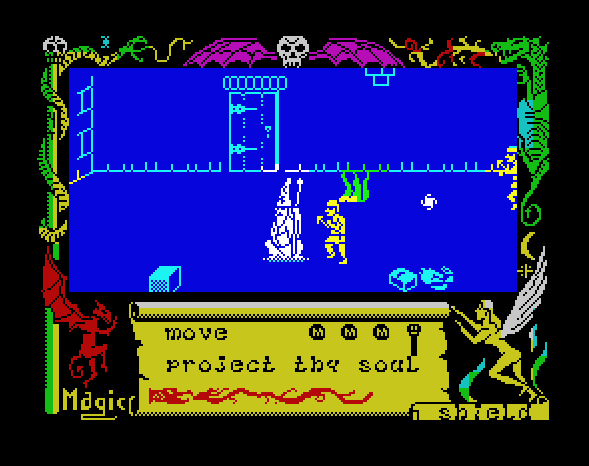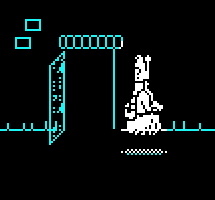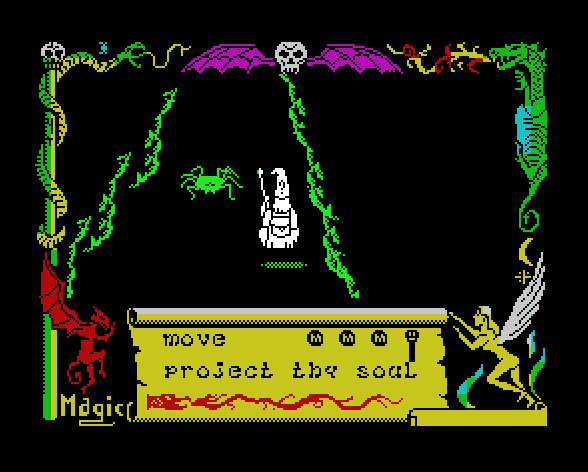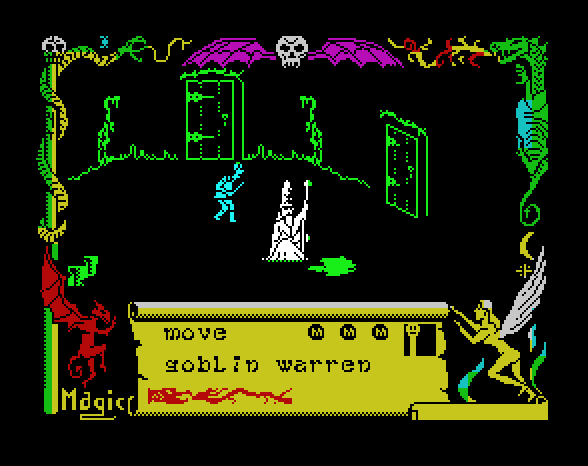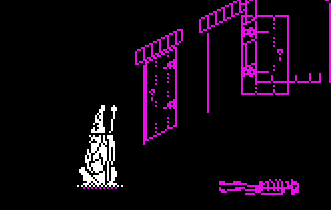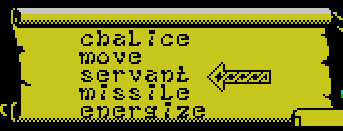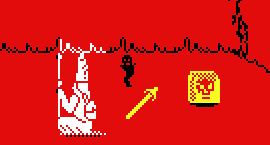Avalon - the game
(Big thanks to Steve Turner for all the help, pointers, backgrounds and original artwork for this disassembly).
Avalon, the
"3D Adventure Movie", as described on the game
Inlay, was released in 1984 to critical acclaim, earning itself a Crash Smash and C&VG Game of the Month.
An arcade-adventure game, steeped in the legend of King Arthur, it tells the story of Maroc the Mage, who descends deep into the Isle of Glass to do battle with Avelach, Lord of Chaos.
One of the reasons for wanting to attempt a disassembly of Avalon was that not only is it a detailed game with depth of gameplay, but there are also plenty of small touches in game design that wasn't present in a lot of other games at the time.
Its sequel, Dragontorc, built on Avalon's success in size, scope and imagination, but it was Avalon that first brought us the immersive world of Maroc the Mage and his pseudo-3D environment.
Maroc the Mage
Avalon's protagonist is Maroc the Mage - or rather his astral projection. Maroc floats around the world searching for spells and objects, in a bid to delve deeper into the isle.
Maroc's sprite has an impressive 8 animation frames, and he also rises and falls above his shadow depending on how fast he's moving.
The rooms
There are two types of room in Avalon. Standard rooms, and tunnels.
The short, vertically tunnel section provide link different levels, occasionally throwing in a bat or spider for the player to avoid.
Some tunnels - particuarly the longer ones - can be almost as dangerous as some of the standard rooms. Bats in particular are tricky to avoid and can drain a lot of Maroc's energy if he's unlucky.
Additionally, Maroc can't access his spell menu during these sections - the only thing the player needs to do is to avoid collisions with the side walls, spiders and bats.
Standard rooms vary in size and orientation. Each level isn't particularly big, and the variety of room sizes, scenery and door positions makes them feel quite distinct.
However, the map still has a labyrinthine feel to it. Maroc can exit a door on the left of one room to emerge from a door on the back wall in the next one.
While many other games have fixed-screen rooms, Avalon also scrolls the rooms in all directions.
The advantage of scrolling up and down in a room (as well as left/right) provides some extra manoevring space at the bottom sides of the room for Maroc, extending beyond the side wall markings.
This gives him both physical and breathing space to perform actions while also avoiding hostile creatures.
The spells
"Seek the high magic", Maroc is told at the start of his quest. There are 27 spells (see
Reference - Spells). There's a mix of spell types, including:
- offensive spells such as MISSILE, FIREBOLT and VAPORIZE, which lets Maroc fire deadly missiles at hostile creatures
- instant effect spells such as ENERGIZE (to restore Maroc's energy) and teleport spells such as WAYSTONE and SUMMON
- protective spells, such as WRAITHBANE, SHIELD and AMULET
- spells to manipulate the environment such as DISPEL, REVEAL and UNLOCK
...amongst others. Not all spells are needed to complete the game.
When the player presses the FIRE control, Maroc stops dead and the scroll list is presented. The player needs to select from the list of acquired spells.
As Maroc collects more spells, this list will naturally grow, challenging the player to pick the right option in urgent or dangerous circumstances.
Servant spell
This is the first vital spell that Maroc needs to collect on the first level. Casting SERVANT lets you control a small sprite-like figure that can interact with the world of Avalon.
While the player is controlling the servant, Maroc is immobile on screen. This leaves him vulnerable to attacks from any creatures in the room.
Most of the SERVANT interactions are using one object on another. The SERVANT can collect and deposit objects from and to Maroc's backpack, and move them around the screen.
Later in the game Maroc can acquire two useful items - an animated sabre (
45702) and the sword CALIBURN (
41316). The servant can use these to attack hostile creatures.
The creatures
Avalon is home to an variety of creatures - most of which are hostile towards Maroc. Creatures follow Maroc from room to room, and Maroc needs to move quickly between rooms to stop their pursuit.
Creatures have their own movement patterns, and their actions change depending on the magic that Maroc is wielding (see the creature behaviour routine at
52695).
Warlocks materialize on room walls, occasionally throwing a magic bolt at him if he dallies too much. These, however, can be traded with - Maroc can obtain useful items if he trades objects of sufficient interest.
See the
Creatures section for the full bestiary.
Success & failure
Maroc's aim is to defeat Avelach, Lord of Chaos, who resides in the final room in the High Temple of Chaos.
To accomplish this task, Maroc needs to find the sword CALIBURN, as hinted at in the
Inlay poem. This involves solving various puzzles, using magic spells acquired, and opening the way to the lower levels of Avalon.
So that's the success part - so what about failure?
One of the distinctive aspects of Avalon is that Maroc cannot die.
If he runs out of energy, he's returned to the starting room, with half his energy bar restored. However, the game state is unchanged - Maroc retains any acquired spells and items, and all puzzles, unlocked doors, destroyed creatures etc. will remain that way.
This may be partly due to the game menu routines being overwritten once a new game is started(!). However, this approach has more shades of modern gameplay design than a remnant of typical (and often overly-challenging) 80s game difficulty levels.
The game wants and encourages the player to progress, rather than punishing them for failure. Avalon was one of the few games that I felt I could progress in and potentially finish in the 1980s.
However, it
is possible for the player to put the game into an unwinnable state. For example, Maroc can use up all spell charges using the
FIND spell, which is one of the spells vital for game completion.
Maroc's progress is measured by means of a
Rank.


